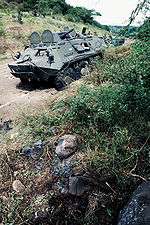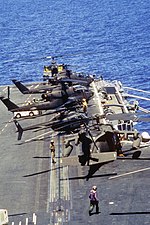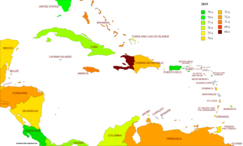Caribbean
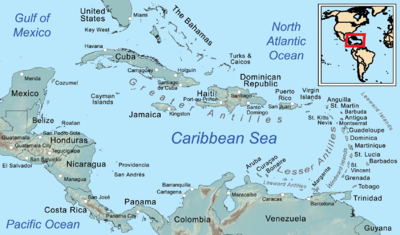 | |
| Area | 239,681 km2(92,541 sq mi) |
|---|---|
| Population | 44,182,048[1][2] |
| Population density | 151.5/km2(392/sq mi) |
| Ethnic groups | Afro-Caribbean,LatinoorHispanic,(Spanish,Portuguese,Criollo,Mestizo,Mulatto,Pardo,andZambo),Indian,European,Chinese,Jewish,Arab,Amerindian,Javanese,[3]Hmong,Multiracial |
| Religions | Christianity,Hinduism,Islam,Afro-American religions,Traditional African religions,Rastafari,Native American religions,Judaism,Buddhism,Chinese folk religions(incl.ConfucianismandTaoism),Bahá'í,Kebatinan,Sikhism,Irreligion,others |
| Demonym | Caribbean,West Indian |
| Countries | 16 |
| Dependencies | 12 |
| Languages | |
| Time zones | UTC−05:00toUTC−04:00 |
| InternetTLD | Multiple |
| Calling code | Multiple |
| Largest cities | |
| UN M49code | 029– Caribbean419–Latin America and the Caribbean019–Americas001–World |
TheCaribbean(/ˌkærɪˈbiːən,kəˈrɪbiən/KARR-ih-BEE-ən, kə-RIB-ee-ən,locally/ˈkærɪbiːæn/KARR-ih-bee-an;[4]Spanish:el Caribe;French:les Caraïbes;Dutch:de Caraïben) is asubregionof theAmericasthat includes theCaribbean Seaand itsislands,some of which are surrounded by the Caribbean Sea[5]and some of which border both the Caribbean Sea and the NorthAtlantic Ocean;[6]the nearby coastal areas on themainlandare sometimes also included in the region. The region is south-east of theGulf of MexicoandNorthern America,east ofCentral America,and north ofSouth America.
Situated largely on theCaribbean Plate,the region has thousands ofislands,islets,reefs,andcays.[7]Island arcsdelineate the northern and eastern edges of the Caribbean Sea:[7]theGreater Antillesin the north and theLesser Antilles,which includes theLeeward Antilles,in the east and south. The nearbyLucayan Archipelago,comprisingThe Bahamasand theTurks and Caicos Islands,is considered to be a part of the Caribbean despite not bordering the Caribbean Sea, the same goes forBarbadosin theLesser Antilles.All the islands in theAntillesplus theLucayan Archipelagoform theWest Indies,which is often interchangeable with the term Caribbean. On the mainland,Belize,the eastern and northern coasts of Central and South American countries such as theBay Islands DepartmentofHonduras,theNorthandSouthCaribbean Autonomous Regions ofNicaragua,theLimón ProvinceofCosta Rica,and theArchipelago of San Andrés, Providencia and Santa CatalinaofColombiaare also considered culturally Caribbean.[8]French Guiana,Guyana,Panama,andSurinameare often included as parts of the Caribbean due to theirpoliticalandculturalties with the region.
Geopolitically,theislands of the Caribbeanare often regarded as a subregion ofNorth America,though sometimes they are included inMiddle Americaor left as a subregion of their own;[9][10]alternately, the term "Caribbean" may have the intended exclusion, or even unintentional inclusion, as part ofLatin America.Generally the Caribbean area is organized into 33political entities,including 13sovereign states,12dependencies,historicaldisputed territorieshave existed, and seven otheroverseas territories.From 15 December 1954 to 10 October 2010, there was a territory known as theNetherlands Antillescomposed of five islands, all of which wereDutchdependencies.[11]From 3 January 1958 to 31 May 1962, there was also a short-lived political union called the BritishWest Indies Federationcomposed of tenEnglish-speaking Caribbean territories, all of which were thenBritishdependencies.
Because of a history of waves of immigration brought by colonization by the Spanish, English, Dutch, and French, theAtlantic slave tradefromAfrica,andindentured servitudefromAsia,as well as modern immigration, the modern Caribbean is one of the most ethnically diverse regions on the planet with persons of all these ethnic backgrounds.
Etymology and pronunciation
[edit]The region takes its name from that of theCaribs,anethnic grouppresent in theLesser Antillesand parts of adjacent South America at the time of theSpanish conquest of the Americas.[12]
The two most prevalent pronunciations of "Caribbean" outside the Caribbean are/ˌkærɪˈbiːən/(KARR-ə-BEE-ən), with the primarystresson the thirdsyllable,and/kəˈrɪbiən/(kə-RIB-ee-ən), with the stress on the second. Most authorities of the last century preferred the stress on the third syllable.[13]This is the older of the two pronunciations, but the stressed-second-syllable variant has been established for over 75 years.[14]It has been suggested that speakers ofBritish Englishprefer/ˌkærɪˈbiːən/(KARR-ə-BEE-ən) whileNorth American speakersmore typically use/kəˈrɪbiən/(kə-RIB-ee-ən),[15]but major American dictionaries and other sources list the stress on the third syllable as more common inAmerican Englishtoo.[16][17][18][19]According to the American version of Oxford Online Dictionaries, the stress on the second syllable is becoming more common in UK English and is increasingly considered "by some" to be more up to date and more "correct".[20]
The Oxford Online Dictionaries claim that the stress on the second syllable is the most common pronunciation in the Caribbean itself, but according to the Dictionary of Caribbean English Usage, the most common pronunciation inCaribbean Englishstresses the first syllable instead,/ˈkærɪbiæn/(KARR-ih-bee-an).[4][20]
Definition
[edit]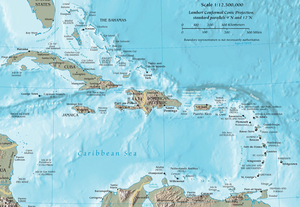
The word "Caribbean" has multiple uses. Its principal ones are geographical and political. The Caribbean can also be expanded to include territories with strong cultural and historical connections to Africa,slavery,European colonisationand theplantation system.
- TheUnited Nations geoscheme for the Americaspresents the Caribbean as a distinct region within theAmericas.
- Physiographically, the Caribbean region is mainly a chain of islands surrounding the Caribbean Sea. To the north, the region is bordered by theGulf of Mexico,theStraits of Floridaand the NorthernAtlantic Ocean,which lies to the east and northeast. To the south lies the coastline of thecontinentofSouth America.
Countries and territories list
[edit]History
[edit]
The oldest evidence of humans in the Caribbean is in southernTrinidadatBanwari Trace,where remains have been found from seven thousand years ago. These pre-ceramic sites, which belong to the Archaic (pre-ceramic) age, have been termedOrtoiroid.The earliest archaeological evidence of human settlement inHispanioladates to about 3600 BC, but the reliability of these finds is questioned. Consistent dates of 3100 BC appear inCuba.The earliest dates in theLesser Antillesare from 2000 BC inAntigua.A lack of pre-ceramic sites in theWindward Islandsand differences in technology suggest that these Archaic settlers may have Central American origins. Whether an Ortoiroid colonization of the islands took place is uncertain, but there is little evidence of one.
DNAstudies changed some of the traditional beliefs about pre-Columbian indigenous history. According toNational Geographic,"studies confirm that a wave of pottery-making farmers—known as Ceramic Age people—set out in canoes from the northeastern coast of South America starting some 2,500 years ago and island-hopped across the Caribbean. They were not, however, the first colonizers. On many islands they encountered a foraging people who arrived some 6,000 or 7,000 years ago...The ceramicists, who are related to today'sArawak-speaking peoples, supplanted the earlier foraging inhabitants—presumably through disease or violence—as they settled new islands. "[29]
Between 400 BC and 200 BC, the first ceramic-using agriculturalists, theSaladoid culture,entered Trinidad from South America. They expanded up the Orinoco River to Trinidad, and then spread rapidly up the islands of the Caribbean. Some time after 250 AD another group, theBarancoid,entered Trinidad. The Barancoid society collapsed along the Orinoco around 650 AD and another group, theArauquinoid,expanded into these areas and up the Caribbean chain. Around 1300 AD a new group, theMayoid,entered Trinidad and remained the dominant culture until Spanish settlement.
At the time of the European discovery of most of the islands of the Caribbean, three major Amerindian indigenous peoples lived on the islands: theTaínoin theGreater Antilles,the Bahamasand theLeeward Islands,theIsland CaribsandGalibiin the Windward Islands, and theCiboneyin western Cuba. The Taínos are subdivided into Classic Taínos, who occupied Hispaniola andPuerto Rico,Western Taínos, who occupied Cuba,Jamaica,and the Bahamian archipelago, and the Eastern Taínos, who occupied the Leeward Islands. Trinidad was inhabited by both Carib speaking and Arawak-speaking groups.
European contact
[edit]Soon afterChristopher Columbuscame to the Caribbean, both Portuguese and Spanish explorers began claiming territories in Central and South America. These early colonies brought gold to Europe; most specifically England, the Netherlands, and France. These nations hoped to establish profitable colonies in the Caribbean. Colonial rivalries made the Caribbean a cockpit for European wars for centuries.
Columbus, and the early colonists of Hispaniola, treated the indigenous peoples brutally, even enslaving children.[30]In 1512, after pressure from Dominican friars, theLaws of Burgoswere introduced by the Spanish Crown to better protect the rights of the New World natives. The Spanish used a form of slavery called theEncomienda,where slaves would be awarded to the conquistadors, who were charged with protecting and converting their slaves. This had a devastating impact on the population,[31]so starting in 1503, slaves from Africa were imported to the colony.
While early slave traders were Portuguese and Spanish, known as the First Atlantic System, by the 17th century the trade became dominated by British, French, and Dutch merchants. This was known as the Second Atlantic System. 5 million African slaves would be taken to the Caribbean, and around half would be traded to the British Caribbean islands. Slavery was abolished first in the Dutch Empire in 1814. Spain abolished slavery in its empire in 1811, with the exceptions of Cuba, Puerto Rico, and Santo Domingo. Slavery was not abolished in Cuba until 1886.[32]Britainabolished the slave trade in 1807,andslavery proper in 1833.France abolished slavery in its colonies in 1848.

The Caribbean was known forpirates,especially between 1640 and 1680. The term "buccaneer"is often used to describe a pirate operating in this region. The Caribbean region was war-torn throughout much of its colonial history, but the wars were often based in Europe, with only minor battles fought in the Caribbean. Some wars, however, were born of political turmoil in the Caribbean itself.
In 1791,a slave rebellionin the French colony of Saint-Domingue led to the establishment in 1804 ofHaiti,the first republic in the Caribbean. Neighboring Santo Domingo (nowDominican Republic) would attain its independence on three separate occasions in 1821, 1844 and 1865. Cuba became independent in 1898 following American intervention in theWar of Independenceduring theSpanish-American war.Following the war, Spain's last colony in the Americas,Puerto Rico,became an unincorporated territory of the United States.
Decolonisation and modern period
[edit]Between the 1960s and 80s, most of the British holdings in the Caribbean achieved political independence, starting withJamaica in 1962,thenTrinidad and Tobago(1962),British Guiana(1966),Barbados(1966),Bahamas(1973),Grenada(1974),Dominica(1978),St. Lucia(1979),St. Vincent(1979),Antigua and Barbuda(1981),St. Kitts and Nevis(1983). Presently, the United States, Britain, France and the Netherlands still have someCaribbean possessions.
The decline of the export industries meant a need to diversify the economies of the Caribbean territories.The tourism industrystarted developing in the early 20th century, rapidly developing in the 1960s when regular international flights made vacations affordable and is now a $50 billion industry. Another industry that developed in the early 20th century wasoffshore banking and financial services,particularly in The Bahamas and theCayman Islands,as the proximity of the Caribbean islands to North America made them an attractive location for branches of foreign banks seeking to avail themselves of less complicated regulations and lower tax rates.
US interventions
[edit]TheUnited Stateshas conducted military operations in the Caribbean for at least 100 years.[33]
Since theMonroe Doctrine,the United States gained a major influence on most Caribbean nations. In the early part of the 20th century this influence was extended by participation in theBanana Wars.Victory in the Spanish–American War and the signing of thePlatt Amendmentin 1901 ensured that the United States would have the right to interfere in Cuban political and economic affairs, militarily if necessary. After theCuban Revolutionof 1959, relations deteriorated rapidly leading to theBay of Pigs Invasion,theCuban Missile Crisis,and successive US attempts to destabilize the island, based uponCold Warfears of theSovietthreat. The US invaded and occupied Hispaniola for 19 years (1915–34), subsequently dominating the Haitian economy through aid and loan repayments. The US invaded Haiti againin 1994and in 2004 were accused byCARICOMof arranging acoup d'étatto remove elected Haitian leader Jean-Bertrand Aristide. In 1965, 23,000 US troops were sent to the Dominican Republic to quash a local uprising against military rule (seeDominican Civil War). President Lyndon Johnson had ordered the invasion to stem what he deemed to be a "Communist threat." However, the mission appeared ambiguous and was roundly condemned throughout the hemisphere as a return togunboat diplomacy.In 1983, the USinvaded Grenadato remove populist left-wing leader Maurice Bishop. The US maintains a naval military base in Cuba atGuantanamo Bay.The base is one of five unified commands whose "area of responsibility" isLatin Americaand the Caribbean. The command is headquartered in Miami, Florida.
-
Counter-attack byCuban Revolutionary Armed Forcessupported byT-34tanks near Playa Giron during theBay of Pigs Invasion,19 April 1961.
-
AMarineheavy machine gunner monitors a position along the international neutral corridor in Santo Domingo, 1965.
-
A Soviet-madeBTR-60armored personnel carrier seized by US forces duringOperation Urgent Fury(1983)
-
US ArmySikorsky UH-60 Black Hawk,Bell AH-1 CobraandBell OH-58 Kiowahelicopters on deck of the US Navy aircraft carrier USSDwight D. Eisenhower(CVN-69) off Haiti, 1994.
Geography and geology
[edit]
The geography and climate in the Caribbean region varies: Some islands in the region have relatively flat terrain of non-volcanic origin. These islands includeAruba(possessing only minor volcanic features),Curaçao,Barbados,Bonaire,theCayman Islands,Saint Croix,the Bahamas,andAntigua.Others possess rugged towering mountain-ranges like the islands ofSaint Martin,Cuba,Hispaniola,Puerto Rico,Jamaica,Dominica,Montserrat,Saba,Sint Eustatius,Saint Kitts,Saint Lucia,Saint Thomas,Saint John,Tortola,Grenada,Saint Vincent,Guadeloupe,MartiniqueandTrinidad and Tobago.
Definitions of the terms Greater Antilles and Lesser Antilles often vary. The Virgin Islands as part of the Puerto Rican bank are sometimes included with the Greater Antilles. The term Lesser Antilles is often used to define an island arc that includes Grenada but excludes Trinidad and Tobago and the Leeward Antilles.
The waters of the Caribbean Sea host large, migratory schools of fish, turtles, andcoral reefformations. ThePuerto Rico Trench,located on the fringe of the Atlantic Ocean and Caribbean Sea just to the north of the island of Puerto Rico, is the deepest point in all of the Atlantic Ocean.[34]
The region sits in the line of several major shipping routes with thePanama Canalconnecting the western Caribbean Sea with the Pacific Ocean.
Climate
[edit]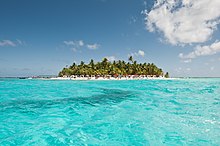

The climate of the area istropical,varying fromtropical rainforestin some areas totropical monsoonandtropical savannain others. There are also some locations that arearidclimates with considerable drought in some years, and the peaks of mountains tend to have coolertemperate climates.
Rainfall varies with elevation, size and water currents, such as the cool upwellings that keep theABC islandsarid. Warm, moisttrade windsblow consistently from the east, creating both rain forest and semi arid climates across the region. The tropical rainforest climates include lowland areas near the Caribbean Sea fromCosta Ricanorth toBelize,as well as theDominican RepublicandPuerto Rico,while the more seasonal dry tropical savanna climates are found inCuba,northernColombiaandVenezuela,and southernYucatán, Mexico.Arid climates are found along the extreme northern coast of Venezuela out to the islands includingArubaandCuracao,as well as the northwestern tip of Yucatán.
While the region generally is sunny much of the year, the wet season from May through November sees more frequent cloud cover (both broken and overcast), while the dry season from December through April is more often clear to mostly sunny. Seasonal rainfall is divided into 'dry' and 'wet' seasons, with the latter six months of the year being wetter than the first half. The air temperature is hot much of the year, varying from 25 to 33 C (77 F to 90 F) between the wet and dry seasons. Seasonally, monthly mean temperatures vary from only about 5 C (7 F) in the northern most regions, to less than 3 C in the southernmost areas of the Caribbean.
Hurricane season is from June to November, but they occur more frequently in August and September and more common in the northern islands of the Caribbean.Hurricanesthat sometimes batter the region usually strike northwards ofGrenadaand to the west of Barbados. The principal hurricane belt arcs to northwest of the island of Barbados in the Eastern Caribbean. A great example being recent events ofHurricane Irmadevastating the island of Saint Martin during the 2017 hurricane season.
Sea surface temperatures change little annually, normally running from 30 °C (87 °F) in the warmest months to 26 °C (76 °F) in the coolest months. The air temperature is warm year round, in the 70s, 80s and 90s, and only varies from winter to summer about 2–5 degrees on the southern islands and about a 10–20 degrees difference on the northern islands of the Caribbean. The northern islands, like the Bahamas, Cuba, Puerto Rico and the Dominican Republic, may be influenced by continental masses during winter months, such as cold fronts.
Aruba: Latitude 12°N
| Climate data for Oranjestad, Aruba (1981–2010, extremes 1951–2010) | |||||||||||||
|---|---|---|---|---|---|---|---|---|---|---|---|---|---|
| Month | Jan | Feb | Mar | Apr | May | Jun | Jul | Aug | Sep | Oct | Nov | Dec | Year |
| Record high °C (°F) | 32.5 (90.5) |
33.0 (91.4) |
33.9 (93.0) |
34.4 (93.9) |
34.9 (94.8) |
35.2 (95.4) |
35.3 (95.5) |
36.1 (97.0) |
36.5 (97.7) |
35.4 (95.7) |
35.0 (95.0) |
34.8 (94.6) |
36.5 (97.7) |
| Mean daily maximum °C (°F) | 30.0 (86.0) |
30.4 (86.7) |
30.9 (87.6) |
31.5 (88.7) |
32.0 (89.6) |
32.2 (90.0) |
32.0 (89.6) |
32.6 (90.7) |
32.7 (90.9) |
32.1 (89.8) |
31.3 (88.3) |
30.4 (86.7) |
31.5 (88.7) |
| Daily mean °C (°F) | 26.7 (80.1) |
26.8 (80.2) |
27.2 (81.0) |
27.9 (82.2) |
28.5 (83.3) |
28.7 (83.7) |
28.6 (83.5) |
29.1 (84.4) |
29.2 (84.6) |
28.7 (83.7) |
28.1 (82.6) |
27.2 (81.0) |
28.1 (82.6) |
| Mean daily minimum °C (°F) | 24.5 (76.1) |
24.7 (76.5) |
25.0 (77.0) |
25.8 (78.4) |
26.5 (79.7) |
26.7 (80.1) |
26.4 (79.5) |
26.8 (80.2) |
26.9 (80.4) |
26.4 (79.5) |
25.8 (78.4) |
25.0 (77.0) |
25.9 (78.6) |
| Record low °C (°F) | 21.3 (70.3) |
20.6 (69.1) |
21.4 (70.5) |
21.5 (70.7) |
21.8 (71.2) |
22.7 (72.9) |
21.2 (70.2) |
21.3 (70.3) |
22.1 (71.8) |
21.9 (71.4) |
22.0 (71.6) |
20.5 (68.9) |
20.5 (68.9) |
| Averageprecipitationmm (inches) | 39.3 (1.55) |
20.6 (0.81) |
8.7 (0.34) |
11.6 (0.46) |
16.3 (0.64) |
18.7 (0.74) |
31.7 (1.25) |
25.8 (1.02) |
45.5 (1.79) |
77.8 (3.06) |
94.0 (3.70) |
81.8 (3.22) |
471.8 (18.58) |
| Source: DEPARTAMENTO METEOROLOGICO ARUBA,[35](extremes)[36] | |||||||||||||
Puerto Rico: Latitude 18°N
| Climate data for San Juan, Puerto Rico | |||||||||||||
|---|---|---|---|---|---|---|---|---|---|---|---|---|---|
| Month | Jan | Feb | Mar | Apr | May | Jun | Jul | Aug | Sep | Oct | Nov | Dec | Year |
| Record high °C (°F) | 33 (92) |
36 (96) |
36 (96) |
36 (97) |
36 (96) |
36 (97) |
35 (95) |
35 (95) |
36 (97) |
36 (97) |
37 (98) |
36 (96) |
34 (94) |
| Mean daily maximum °C (°F) | 28 (83) |
29 (84) |
29 (85) |
30 (86) |
31 (87) |
32 (89) |
31 (88) |
31 (88) |
32 (89) |
31 (88) |
30 (86) |
29 (84) |
30 (86) |
| Mean daily minimum °C (°F) | 22 (72) |
22 (72) |
23 (73) |
23 (74) |
24 (76) |
26 (78) |
26 (78) |
26 (78) |
26 (78) |
25 (77) |
24 (75) |
23 (73) |
24 (75) |
| Record low °C (°F) | 16 (61) |
17 (62) |
16 (60) |
18 (64) |
18 (64) |
19 (66) |
21 (69) |
20 (68) |
21 (69) |
19 (67) |
18 (65) |
17 (62) |
16 (61) |
| Averageprecipitationmm (inches) | 95 (3.7) |
60 (2.4) |
49 (1.9) |
118 (4.6) |
150 (5.9) |
112 (4.4) |
128 (5.0) |
138 (5.4) |
146 (5.7) |
142 (5.6) |
161 (6.3) |
126 (5.0) |
1,431 (56.3) |
| Source: The National Weather Service[37] | |||||||||||||
Cuba: at Latitude 22°N
| Climate data for Havana | |||||||||||||
|---|---|---|---|---|---|---|---|---|---|---|---|---|---|
| Month | Jan | Feb | Mar | Apr | May | Jun | Jul | Aug | Sep | Oct | Nov | Dec | Year |
| Record high °C (°F) | 32.5 (90.5) |
33.0 (91.4) |
35.9 (96.6) |
36.4 (97.5) |
36.9 (98.4) |
37.2 (99.0) |
38.0 (100.4) |
36.1 (97.0) |
37.5 (99.5) |
35.4 (95.7) |
35.0 (95.0) |
34.8 (94.6) |
38.0 (100.4) |
| Mean daily maximum °C (°F) | 25.8 (78.4) |
26.1 (79.0) |
27.6 (81.7) |
28.6 (83.5) |
29.8 (85.6) |
30.5 (86.9) |
31.3 (88.3) |
31.6 (88.9) |
31.0 (87.8) |
29.2 (84.6) |
27.7 (81.9) |
26.5 (79.7) |
28.8 (83.8) |
| Daily mean °C (°F) | 22.2 (72.0) |
22.4 (72.3) |
23.7 (74.7) |
24.8 (76.6) |
26.1 (79.0) |
27.0 (80.6) |
27.6 (81.7) |
27.9 (82.2) |
27.4 (81.3) |
26.1 (79.0) |
24.5 (76.1) |
23.0 (73.4) |
25.2 (77.4) |
| Mean daily minimum °C (°F) | 18.6 (65.5) |
18.6 (65.5) |
19.7 (67.5) |
20.9 (69.6) |
22.4 (72.3) |
23.4 (74.1) |
23.8 (74.8) |
24.1 (75.4) |
23.8 (74.8) |
23.0 (73.4) |
21.3 (70.3) |
19.5 (67.1) |
21.6 (70.9) |
| Record low °C (°F) | 5.1 (41.2) |
5.6 (42.1) |
5.4 (41.7) |
11.5 (52.7) |
16.8 (62.2) |
19.7 (67.5) |
18.2 (64.8) |
19.3 (66.7) |
19.1 (66.4) |
11.9 (53.4) |
10.0 (50.0) |
7.5 (45.5) |
5.1 (41.2) |
| Average rainfall mm (inches) | 64.4 (2.54) |
68.6 (2.70) |
46.2 (1.82) |
53.7 (2.11) |
98.0 (3.86) |
182.3 (7.18) |
105.6 (4.16) |
99.6 (3.92) |
144.4 (5.69) |
180.5 (7.11) |
88.3 (3.48) |
57.6 (2.27) |
1,189.2 (46.84) |
| Source:World Meteorological Organisation(UN),[38]Climate-Charts[39] | |||||||||||||
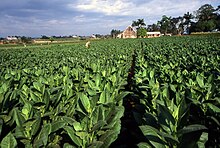

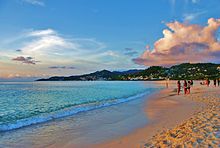
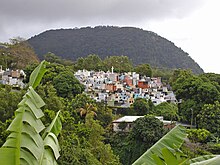
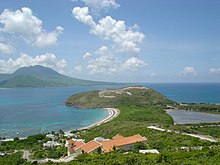
Island groups
[edit] The Bahamas
The Bahamas Turks and Caicos Islands(United Kingdom)
Turks and Caicos Islands(United Kingdom)
 Cayman Islands(United Kingdom)
Cayman Islands(United Kingdom) Cuba
Cuba- Hispaniola
 Jamaica
Jamaica Puerto Rico(U.S. Commonwealth)
Puerto Rico(U.S. Commonwealth)
 Navassa Island
Navassa Island
- Leeward Islands
 United States Virgin Islands(U.S.)
United States Virgin Islands(U.S.)
 British Virgin Islands(United Kingdom)
British Virgin Islands(United Kingdom)
 Anguilla(United Kingdom)
Anguilla(United Kingdom) Antigua and Barbuda
Antigua and Barbuda
- Saint Martin,politically divided between
 Saba(Caribbean Netherlands,Netherlands)
Saba(Caribbean Netherlands,Netherlands) Sint Eustatius(Caribbean Netherlands,Netherlands)
Sint Eustatius(Caribbean Netherlands,Netherlands) Saint Barthélemy(French Antilles,France)
Saint Barthélemy(French Antilles,France) Saint Kitts and Nevis
Saint Kitts and Nevis
 Montserrat(United Kingdom)
Montserrat(United Kingdom) Guadeloupe(French Antilles,France) including
Guadeloupe(French Antilles,France) including
- Windward Islands
- Leeward Antilles
Historical groupings
[edit]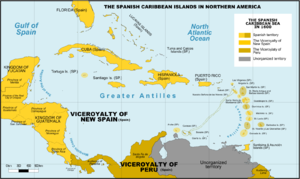



All islands at some point were, and a few still are,coloniesof European nations; a few areoverseas or dependent territories:
- British West Indies/Anglophone Caribbean–Anguilla,Antigua and Barbuda,Bahamas,Barbados,Bay Islands,Guyana,Belize,British Virgin Islands,Cayman Islands,Dominica,Grenada,Jamaica,Montserrat,Saint Croix(briefly),Saint Kitts and Nevis,Saint Lucia,Saint Vincent and the Grenadines,Trinidad and Tobago(from 1797) and theTurks and Caicos Islands
- Danish West Indies– Possession ofDenmark-Norwaybefore1814,thenDenmark,present-dayUnited States Virgin Islands
- Dutch West Indies–Aruba,Bonaire,Curaçao,Saba,Sint Eustatius,Sint Maarten,Bay Islands(briefly),Saint Croix(briefly),Tobago,SurinamandVirgin Islands
- French West Indies–Anguilla(briefly),Antigua and Barbuda(briefly),Dominica,Dominican Republic(briefly),Grenada,Haiti(formerlySaint-Domingue),Montserrat(briefly),Saint Lucia,Saint Vincent and the Grenadines,Sint Eustatius(briefly),Sint Maarten,St. Kitts(briefly),Tobago(briefly),Saint Croix,the current FrenchoverseasdépartementsofFrench Guiana,MartiniqueandGuadeloupe(includingMarie-Galante,La DésiradeandLes Saintes), the current Frenchoverseas collectivitiesofSaint BarthélemyandSaint Martin
- Portuguese West Indies– present-dayBarbados,known asOs Barbadosin the 16th century when the Portuguese claimed the island en route to Brazil. The Portuguese left Barbados abandoned years before the British arrived.
- Spanish West Indies–Cuba,Hispaniola(present-dayDominican Republic),Haiti(until 1659, lost to France),Puerto Rico,Jamaica(until 1655, lost to Great Britain), theCayman Islands(until 1670 to Great Britain)Trinidad(until 1797, lost to Great Britain) andBay Islands(until 1643, lost to Great Britain), coastal islands ofCentral America(except Belize), and some Caribbean coastal islands ofPanama,Colombia,Mexico,andVenezuela.
- Swedish West Indies– present-day FrenchSaint-Barthélemy,Guadeloupe(briefly) andTobago(briefly).
- Courlander West Indies–Tobago(until 1691)
The British West Indies were united by the United Kingdom into aWest Indies Federationbetween 1958 and 1962. The independent countries formerly part of the B.W.I. still have a jointcricketteam that competes inTest matches,One Day InternationalsandTwenty20 Internationals.TheWest Indian cricket teamincludes the South American nation ofGuyana,the only former British colony on the mainland of that continent.
In addition, these countries share theUniversity of the West Indiesas a regional entity. The university consists of three main campuses in Jamaica, Barbados and Trinidad and Tobago, a smaller campus in the Bahamas and Resident Tutors in other contributing territories such as Trinidad.
Continental countries with Caribbean coastlines and islands
[edit] Belize
Belize
 Colombia
Colombia
 Costa Rica
Costa Rica
 Guatemala
Guatemala Honduras
Honduras
 Nicaragua
Nicaragua
 Panama
Panama
- Archipelago offGuna Yalacoast (including theSan Blas Islands)
- Bocas del Toro Archipelago(approximately 300 islands)
- Galeta Island (Panama)
- Isla Grande
- Soledad Miria
 Mexico
Mexico
 Venezuela
Venezuela
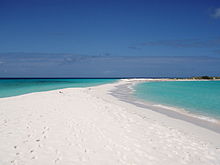

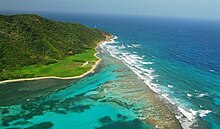
Biodiversity
[edit]The Caribbean islands have one of the most diverse eco systems in the world. The animals, fungi and plants, and have been classified as one ofConservation International'sbiodiversity hotspotsbecause of their exceptionally diverse terrestrial and marine ecosystems, ranging from montanecloud forests,totropical rainforest,tocactusscrublands.The region also contains about 8% (by surface area) of the world's coral reefs[40]along with extensive seagrass meadows,[41]both of which are frequently found in the shallow marine waters bordering the island and continental coasts of the region.
For the fungi, there is a modern checklist based on nearly 90,000 records derived from specimens in reference collections, published accounts and field observations.[42]That checklist includes more than 11,250 species of fungi recorded from the region. As its authors note, the work is far from exhaustive, and it is likely that the true total number of fungal species already known from the Caribbean is higher. The true total number of fungal species occurring in the Caribbean, including species not yet recorded, is likely far higher given the generally accepted estimate that only about 7% of all fungi worldwide have been discovered.[43]Though the amount of available information is still small, a first effort has been made to estimate the number of fungal species endemic to some Caribbean islands. For Cuba, 2200 species of fungi have been tentatively identified as possible endemics of the island;[44]forPuerto Rico,the number is 789 species;[45]for theDominican Republic,the number is 699 species;[46]for Trinidad and Tobago, the number is 407 species.[47]
Many of theecosystemsof the Caribbean islands have been devastated bydeforestation,pollution, and human encroachment. The arrival of the first humans is correlated with extinction ofgiantowlsanddwarf ground sloths.[48]The hotspot contains dozens of highly threatened animals (ranging from birds, to mammals and reptiles), fungi and plants. Examples of threatened animals include thePuerto Rican amazon,two species ofsolenodon(giant shrews) in Cuba and the Hispaniola island, and theCuban crocodile.
The region's coral reefs, which contain about 70 species of hard corals and from 500 to 700 species of reef-associated fishes[49]have undergone rapid decline in ecosystem integrity in recent years, and are considered particularly vulnerable to global warming and ocean acidification.[50]According to aUNEPreport, the Caribbean coral reefs might get extinct in next 20 years due to population explosion along the coast lines, overfishing, the pollution of coastal areas and global warming.[51]
Some Caribbean islands have terrain that Europeans found suitable for cultivation for agriculture.Tobaccowas an important early crop during the colonial era, but was eventually overtaken bysugarcaneproduction as the region's staple crop. Sugar was produced from sugarcane for export to Europe.CubaandBarbadoswere historically the largest producers ofsugar.The tropical plantation system thus came to dominate Caribbean settlement. Other islands were found to have terrain unsuited foragriculture,for exampleDominica,which remains heavily forested. The islands in the southernLesser Antilles,Aruba,BonaireandCuraçao,are extremely arid, making them unsuitable for agriculture. However, they havesaltpans that were exploited by the Dutch. Sea water was pumped into shallow ponds, producing coarse salt when the water evaporated.[52]
The natural environmental diversity of the Caribbean islands has led to recent growth ineco-tourism.This type of tourism is growing on islands lacking sandy beaches and dense human populations.[53]
Plants and animals
[edit]-
Epiphytes (bromeliads, climbing palms) in therainforestofDominica
-
A green and black poison frog,Dendrobates auratus
-
Costus speciosus,a marsh plant,Guadeloupe
-
AnAtlantic ghost crab(Ocypode quadrata) inMartinique
-
Crescentia cujete,or calabash fruit,Martinique
-
Thalassoma bifasciatum(bluehead wrasse fish), overBispira brunnea(social feather duster worms)
-
TwoStenopus hispidus(banded cleaner shrimp) on aXestospongia muta(giant barrel sponge)
-
A pair ofCyphoma signatum(fingerprint cowry), off coastalHaiti
-
TheMartinique amazon,Amazona martinicana,is an extinct species of parrot in the family Psittacidae.
-
Anastrepha suspensa,a Caribbean fruit fly
-
Hemidactylus mabouia,a tropical gecko, inDominica.Edited by: Taniya Brooks
Demographics
[edit]Life expectancy
[edit]Life expectancyin some countries of the Caribbean in 2022, according to estimation of theWorld Bank Group:[54][55][56]
| Countries & territories |
2022 | Historical data | recovery from COVID-19: 2019→2022 | |||||||||||
|---|---|---|---|---|---|---|---|---|---|---|---|---|---|---|
| All | Male | Female | Sex gap | 2014 | 2014 →2019 |
2019 | 2019 →2020 |
2020 | 2020 →2021 |
2021 | 2021 →2022 |
2022 | ||
| 80.55 | 77.50 | 83.66 | 6.16 | 79.97 | 0.02 | 79.98 | 0.17 | 80.15 | 0.23 | 80.38 | 0.17 | 80.55 | 0.57 | |
| 80.32 | 77.10 | 83.70 | 6.60 | 78.87 | 0.80 | 79.67 | 0.15 | 79.82 | 0.25 | 80.07 | 0.25 | 80.32 | 0.65 | |
| 79.72 | 75.58 | 83.90 | 8.32 | 78.93 | 0.13 | 79.06 | −1.02 | 78.04 | 2.12 | 80.16 | −0.44 | 79.72 | 0.66 | |
| 79.24 | 76.51 | 81.64 | 5.14 | 77.86 | 0.83 | 78.69 | 0.15 | 78.84 | −0.34 | 78.50 | 0.74 | 79.24 | 0.55 | |
| 78.16 | 75.79 | 80.56 | 4.77 | 77.85 | −0.24 | 77.61 | −0.04 | 77.57 | −3.88 | 73.68 | 4.47 | 78.16 | 0.54 | |
| 77.71 | 75.68 | 79.58 | 3.90 | 76.48 | 0.78 | 77.26 | 0.14 | 77.39 | 0.18 | 77.57 | 0.14 | 77.71 | 0.45 | |
| 76.37 | 73.62 | 79.26 | 5.63 | 75.61 | 0.25 | 75.86 | −0.01 | 75.85 | −1.36 | 74.49 | 1.88 | 76.37 | 0.51 | |
| 75.33 | 72.59 | 78.30 | 5.71 | 74.98 | −0.12 | 74.86 | 0.06 | 74.92 | 0.01 | 74.94 | 0.40 | 75.33 | 0.47 | |
| 74.99 | 72.14 | 77.68 | 5.54 | 75.60 | 0.65 | 76.25 | −0.53 | 75.72 | −1.10 | 74.63 | 0.37 | 74.99 | −1.26 | |
| 74.92 | 72.17 | 77.99 | 5.82 | 77.14 | −1.81 | 75.33 | −0.32 | 75.00 | −0.41 | 74.59 | 0.34 | 74.92 | −0.40 | |
| 74.71 | 71.31 | 78.15 | 6.85 | 74.22 | 0.01 | 74.23 | 0.18 | 74.41 | −1.44 | 72.97 | 1.74 | 74.71 | 0.48 | |
| 74.41 | 71.96 | 77.14 | 5.18 | 76.77 | −1.34 | 75.44 | −0.85 | 74.58 | −0.61 | 73.97 | 0.44 | 74.41 | −1.03 | |
| 74.36 | 70.76 | 77.84 | 7.09 | 73.37 | −2.16 | 71.20 | 1.47 | 72.68 | −1.08 | 71.60 | 2.76 | 74.36 | 3.15 | |
| 74.17 | 71.04 | 77.54 | 6.49 | 72.87 | 0.71 | 73.58 | −0.69 | 72.89 | −0.27 | 72.61 | 1.56 | 74.17 | 0.59 | |
| 72.98 | 69.88 | 76.45 | 6.58 | 69.43 | 4.12 | 73.56 | 0.09 | 73.65 | −0.84 | 72.81 | 0.17 | 72.98 | −0.58 | |
| 72.03 | 68.68 | 75.67 | 6.98 | 70.97 | 0.61 | 71.57 | 0.05 | 71.63 | 0.06 | 71.68 | 0.34 | 72.03 | 0.45 | |
| World | 72.00 | 69.60 | 74.53 | 4.93 | 71.88 | 1.10 | 72.98 | −0.74 | 72.24 | −0.92 | 71.33 | 0.67 | 72.00 | −0.98 |
| Caribbean small states | 71.63 | 68.84 | 74.50 | 5.66 | 72.68 | −0.16 | 72.52 | 0.06 | 72.58 | −1.58 | 71.00 | 0.63 | 71.63 | −0.89 |
| 71.29 | 68.00 | 74.89 | 6.88 | 72.86 | 0.58 | 73.44 | −0.03 | 73.42 | −2.30 | 71.11 | 0.18 | 71.29 | −2.15 | |
| 70.63 | 68.53 | 72.74 | 4.20 | 72.98 | −1.22 | 71.77 | 0.10 | 71.87 | −1.37 | 70.50 | 0.13 | 70.63 | −1.14 | |
| 68.97 | 66.69 | 71.73 | 5.04 | 74.47 | −1.64 | 72.83 | −0.71 | 72.13 | −2.50 | 69.63 | −0.66 | 68.97 | −3.86 | |
| 63.73 | 60.89 | 66.69 | 5.80 | 62.99 | 1.27 | 64.25 | −0.20 | 64.05 | −0.86 | 63.19 | 0.54 | 63.73 | −0.53 | |
| — | — | — | — | — | — | — | — | — | — | 82.01 | — | — | — | |
Indigenous groups
[edit]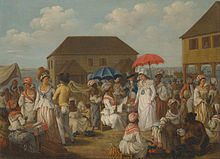
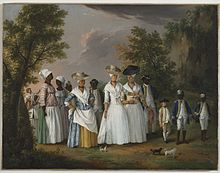

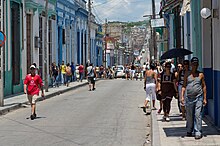
At the time ofEuropean contact,the dominant ethnic groups in the Caribbean included theTaínoof theGreater Antillesand northernLesser Antilles,theIsland Caribsof the southern Lesser Antilles, and smaller distinct groups such as theGuanajatabeyof western Cuba and theCiguayoof eastern Hispaniola. The population of the Caribbean is estimated to have been around 750,000 immediately before European contact, although lower and higher figures are given. After contact, social disruption and epidemic diseases such as smallpox and measles (to which they had no natural immunity)[57]led to a decline in the Amerindian population.[58][59]such as theKongo,Igbo,Akan,FonandYorubaas well as military prisoners fromIreland,who were deported during the Cromwellian reign inEngland.[citation needed]Immigrants fromBritain,Italy,France,Spain,theNetherlands,PortugalandDenmarkalso arrived, although the mortality rate was high for both groups.[60]
The population is estimated to have reached 2.2 million by 1800.[61]Immigrants fromIndia,China,Indonesia,and other countries arrived in the mid-19th century as indentured servants.[62]After the ending of theAtlantic slave trade,the population increased naturally.[63]The total regional population was estimated at 37.5 million by 2000.[64]
InHaitiand most of theFrench,AnglophoneandDutch Caribbean,the population is predominantly ofAfricanorigin; on many islands there are also significant populations of mixed racial origin (includingMulatto-Creole,Dougla,Mestizo,Quadroon,Cholo,Castizo,Criollo,Zambo,Pardo,Asian Latin Americans,Chindian,Cocoa panyols,and Eurasian), as well as populations of European ancestry:Dutch,English,French,Italian,PortugueseandSpanishancestry.Asians,especially those ofChinese,Indiandescent, andJavaneseIndonesians,form a significant minority in parts of the region.Indiansform a plurality of the population inTrinidad and Tobago,Guyana,andSuriname.Most of their ancestors arrived in the 19th century as indentured laborers.
TheSpanish-speaking Caribbeanpopulations are primarily ofEuropean,African, or racially mixed origins.Cubahas a European majority, along with a significant population of African ancestry. Puerto Rico has a mixed race majority with a mixture of European-African-Native American (tri-racial), and a large White and West African (black) minority. The Dominican Republic has the largest mixed-race population, primarily descended from Europeans,West Africans,and Amerindians.

The majority ofJamaicais of West African origin, in addition to a significant population of mixed racial background, and has minorities ofChinese,Europeans,Indians,Latinos,Jews,andArabs.This is a result of years of importation of slaves and indentured laborers, and migration. Most multi-racial Jamaicans refer to themselves as either mixed race or brown. Similar populations can be found in theCaricomstates ofBelize,GuyanaandTrinidad and Tobago.Trinidad and Tobagohas a multi-racial cosmopolitan society due to the arrivals ofAfricans,Indians,Chinese,Arabs,Jews,Latinos,andEuropeansalong with thenative indigenous Amerindianspopulation. This multi-racial mix of the Caribbean has created sub-ethnicities that often straddle the boundaries of major ethnicities and includeMulatto-Creole,Mestizo,Pardo,Zambo,Dougla,Chindian,Afro-Asians,Eurasian,Cocoa panyols,andAsian Latinos.
Language
[edit]Spanish(64%),French(25%),English(14%),Dutch,Haitian Creole,andPapiamentoare the predominant official languages of various countries in the region. However, virtually every Caribbean country has a distinctcreole languageor dialect that often serves as itsvernacular language.Most of these do not enjoy official status, with the aformentioned Haitian Creole and Papiamento being notable exceptions. Other languages such asCaribbean Hindustani,Chinese,Javanese,Arabic,Hmong,Amerindian languages,otherAfrican languages,otherEuropean languages,and otherIndian languagescan also be found.
Religion
[edit]
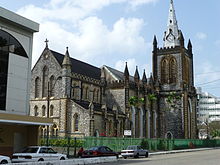

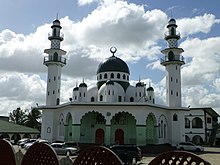
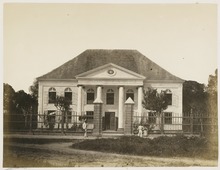

Christianityis the predominant religion in the Caribbean (84.7%).[65]Other religions in the region areHinduism,Islam,Judaism,Rastafari,Buddhism,Chinese folk religion(incl.TaoismandConfucianism),Bahá'í,Jainism,Sikhism,Kebatinan,Traditional African religions,Yoruba(incl.Trinidad Orisha),Afro-American religions,(incl.Santería,Palo,Umbanda,Brujería,Hoodoo,Candomblé,Quimbanda,Orisha,Xangô de Recife, Xangô do Nordeste, Comfa,Espiritismo,Santo Daime,Obeah,Candomblé,Abakuá,Kumina,Winti,Sanse,Cuban Vodú,Dominican Vudú,Louisiana Voodoo,Haitian Vodou,andVodun).
Politics
[edit]Regionalism
[edit]
Caribbean societies are very different from other Western societies in terms of size, culture, and degree of mobility of their citizens.[66]The current economic and political problems the states face individually are common to all Caribbean states. Regional development has contributed to attempts to subdue current problems and avoid projected problems. From a political and economic perspective,regionalismserves to make Caribbean states active participants in current international affairs through collective coalitions. In 1973, the first political regionalism in theCaribbean Basinwas created by advances of the English-speaking Caribbean nations through the institution known as the Caribbean Common Market and Community (CARICOM)[67]which is located in Guyana.
Certain scholars have argued both for and against generalizing the political structures of the Caribbean. On the one hand the Caribbean states are politically diverse, ranging from socialist systems towards more capitalist Westminster-style parliamentary systems. Other scholars argue that these differences are superficial, and that they tend to undermine commonalities in the various Caribbean states. Contemporary Caribbean systems seem to reflect a "blending of traditional and modern patterns, yielding hybrid systems that exhibit significant structural variations and divergent constitutional traditions yet ultimately appear to function in similar ways."[68]The political systems of the Caribbean states share similar practices.
The influence of regionalism in the Caribbean is often marginalized. Some scholars believe that regionalism cannot exist in the Caribbean because each small state is unique. On the other hand, scholars also suggest that there are commonalities amongst the Caribbean nations that suggest regionalism exists. "Proximity as well as historical ties among the Caribbean nations has led to cooperation as well as a desire for collective action."[69]These attempts at regionalization reflect the nations' desires to compete in the international economic system.[69]
Furthermore, a lack of interest from other major states promoted regionalism in the region. In recent years, the Caribbean has suffered from a lack of U.S. interest. "With the end of the Cold War, U.S. security and economic interests have been focused on other areas. As a result there has been a significant reduction in U.S. aid and investment to the Caribbean."[70]The lack of international support for these small, relatively poor states, helped regionalism prosper.
Following the Cold War another issue of importance in the Caribbean has been the reduced economic growth of some Caribbean States due to the United States andEuropean Union's allegations of special treatment toward the region by each other.[clarification needed]
United States–EU trade dispute
[edit]The United States under PresidentBill Clintonlaunched a challenge in theWorld Trade Organizationagainst the EU over Europe's preferential program, known as theLomé Convention,which allowedbananaexports from the former colonies of theGroup of African, Caribbean and Pacific states(ACP) to enter Europe cheaply.[71]The World Trade Organization sided in the United States' favour and the beneficial elements of the convention to African, Caribbean and Pacific states have been partially dismantled and replaced by theCotonou Agreement.[72]
During the US/EU dispute, the United States imposed large tariffs on European Union goods (up to 100%) to pressure Europe to change the agreement with the Caribbean nations in favour of the Cotonou Agreement.[73]
Farmers in the Caribbean have complained of falling profits and rising costs as the Lomé Convention weakens.[74]Some farmers have faced increased pressure to turn towards the cultivation of illegal drugs, which has a higher profit margin and fills the sizable demand for these illegal drugs in North America and Europe.[75][76]
African Union relations
[edit]Many Caribbean nations have sought to deepen ties with the continent ofAfrica.The African Union-bloc has referred to the Caribbean as the potential "Sixth Region" of theAfrican Union.[77]Some Caribbean states have already moved to join Africa institutions including Barbados, Grenada, Guyana, and the Bahamas which have all became members of the African Export Import Bank.[78]And the Caribbean Development Bank signing a cooperation strategic partnership agreement with the African Development Bank (AfDB)[79]At present Antigua and Barbuda, Barbados, Jamaica, Guyana, and Suriname are at various stages of establishing direct air flights with Africa to boost person-to-person links and boost trade between both regions.
The first inter-regional Africa-Caribbean Community (CARICOM) Summit took place in September 2021. In August 2023 the African Union'sAfrican Export–Import Bankofficially opened its first Caribbean Community office in Barbados beginning the process of integrating willing Caribbean states as the 6th region of the African Union.[1][2]
Caribbean Financial Action Task Force and Association of Caribbean States
[edit]Caribbean nations have also started to more closely cooperate in theCaribbean Financial Action Task Forceand other instruments to add oversight of the offshore industry. One of the most important associations that deal with regionalism amongst the nations of theCaribbean Basinhas been theAssociation of Caribbean States(ACS). Proposed by CARICOM in 1992, the ACS soon won the support of the other countries of the region. It was founded in July 1994. The ACS maintains regionalism within the Caribbean on issues unique to the Caribbean Basin. Through coalition building, like the ACS and CARICOM, regionalism has become an undeniable part of the politics and economics of the Caribbean. The successes of region-building initiatives are still debated by scholars, yet regionalism remains prevalent throughout the Caribbean.
Bolivarian Alliance
[edit]The President ofVenezuela,Hugo Chavezlaunched an economic group called theBolivarian Alliance for the Americas(ALBA), which several eastern Caribbean islands joined.
Regional institutions
[edit]Here are some of the bodies that several islands share in collaboration:
- African, Caribbean and Pacific Group of States
- Association of Caribbean States(ACS), Trinidad and Tobago
- Caribbean Association of Industry and Commerce (CAIC), Trinidad and Tobago
- Caribbean Association of National Telecommunication Organizations (CANTO), Trinidad and Tobago[80]
- Caribbean Community(CARICOM), Guyana
- Caribbean Development Bank(CDB), Barbados
- Caribbean Disaster Emergency Management Agency(CDERA), Barbados
- Caribbean Educators Network[81]
- Caribbean Electric Utility Services Corporation (CARILEC), Saint Lucia[82]
- Caribbean Environment Programme(CEP), UN Environment Programme–administeredRegional Seas Programme,secretariat located in Kingston, Jamaica[83]
- Caribbean Examinations Council(CXC), Barbados and Jamaica
- Caribbean Financial Action Task Force(CFATF), Trinidad and Tobago
- Caribbean Food Crops Society,Puerto Rico
- Caribbean Football Union(CFU), Jamaica
- Caribbean Hotel & Tourism Association (CHTA), Florida and Puerto Rico[84]
- Caribbean Initiative(Initiative of the IUCN)
- Caribbean Programme for Economic Competitiveness(CPEC), Saint Lucia
- Caribbean Regional Environmental Programme (CREP), Barbados[85]
- Caribbean Regional Fisheries Mechanism (CRFM), Belize[86]
- Caribbean Regional Negotiating Machinery (CRNM), Barbados and Dominican Republic[87]
- Caribbean Telecommunications Union (CTU), Trinidad and Tobago
- Caribbean Tourism Organization(CTO), Barbados
- Community of Latin American and Caribbean States(CELAC)
- Foundation for the Development of Caribbean Children,Barbados
- Latin America and Caribbean Network Information Centre(LACNIC), Brazil andUruguay
- Latin American and the Caribbean Economic System,Venezuela
- Organisation of Eastern Caribbean States(OECS), Saint Lucia
- United Nations Economic Commission for Latin America and the Caribbean(ECLAC),Chileand Trinidad and Tobago
- University of the West Indies,Jamaica, Trinidad and Tobago, Barbados, and Antigua & Barbuda.[88]In addition, the fourth campus, the Open Campus was formed in June 2008 as a result of an amalgamation of the Board for Non-Campus Countries and Distance Education, Schools of Continuing Studies, the UWI Distance Education Centres and Tertiary Level Units. The Open Campus has 42 physical sites in 16 Anglophone caribbean countries.
- West Indies Cricket Board,Antigua and Barbuda[89]
Cuisine
[edit]Favourite or national dishes
[edit]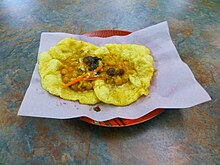
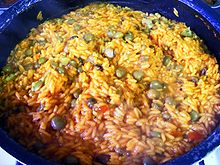
- Anguilla– rice, peas and fish
- Antigua and Barbuda–fungeeandpepperpot
- Bahamas–Guava duff,Conch Salad, Peas n' Rice, andconch fritters
- Barbados–cou-couandflying fish
- Belize– rice and beans, stew chicken with potato salad; white rice, stew beans and fry fish with cole slaw
- British Virgin Islands– fish andfungee
- Cayman Islands– turtle stew, turtle steak,grouper,conch stew, Cayman-style beef with rice and beans, cassava cake
- ColombianCaribbean – rice with coconut milk,arroz con pollo,sancocho,Arab cuisine(due to the large Arab population)
- Cuba–platillo Moros y Cristianos,ropa vieja,lechon,maduros,ajiaco
- Dominica–mountain chicken,rice and peas, dumplings, saltfish, dashin, bakes (fried dumplings), coconut confiture, curry goat, cassavafarine,oxtail
- Dominican Republic–arroz con pollowith stewed redkidney beans,pan friedorbraisedbeef, salad/ ensalada de coditos,empanadas,mangú,sancocho
- Grenada–oil down,Roti and rice & chicken
- Guyana–rotiandcurry,pepperpot,cook-up rice, metemgee,pholourie
- Haiti– griot (fried pork) served with du riz a pois or diri ak pwa (rice and beans)
- Jamaica–ackee and saltfish,callaloo,jerk chicken,curry chicken
- Montserrat–Goat water
- Puerto Rico– yellow rice with greenpigeon peas,saltfish stew, roasted pork shoulder, Puerto Rican style pasteles (root vegetable meat patties), chicken fricassée,pasteles,mofongo,tripe soup,tostones,alcapurria,codfish fritters, coconut custard, rice pudding, guava turnovers, Mallorca bread
- Saint Kitts and Nevis–goat water,coconut dumplings, spicyplantain,saltfish,breadfruit
- Saint Lucia–callaloo,dalroti,dried and salted cod,greenbananas,rice and beans
- Saint Vincent and the Grenadines– roastedbreadfruitand fried jackfish
- Suriname– brown beans and rice,rotiandcurry,peanut soup,batteredfried plantainwithpeanut sauce,nasi goreng,moksi-alesi,bara,pom
- Trinidad and Tobago–doubles,currywithrotiordal bhat,aloo pie,phulourie,callaloo,bake and shark,curry crab and dumpling
- United States Virgin Islands– stewed goat, oxtail or beef, seafood,callaloo,fungee
- VenezuelaCaribbean – fried fish with salad and rise,tostones,sancocho,patacon,pabellon
See also
[edit]- African diaspora
- Anchor coinage
- British African-Caribbean people
- British Indo-Caribbean people
- Caribbean people
- Climate change in the Caribbean
- CONCACAF
- Council on Hemispheric Affairs
- Culture of the Caribbean
- Economy of the Caribbean
- Indian diaspora
- Indo-Caribbean
- Indo-Caribbean American
- List of Caribbean music genres
- List of sovereign states and dependent territories in the Caribbean
- Non-resident Indian and person of Indian origin
- Piracy in the Caribbean
- Politics of the Caribbean
- Democracy in the Caribbean
- Tourism in the Caribbean
Geography:
Notes
[edit]- ^TheLucayan Archipelagois excluded from some definitions of "Caribbean" and instead classified asAtlantic;this is primarily a geological rather than cultural or environmental distinction.
References
[edit]- ^ab"World Population Prospects 2022".United Nations Department of Economic and Social Affairs,Population Division.RetrievedJuly 17,2022.
- ^ab"World Population Prospects 2022: Demographic indicators by region, subregion and country, annually for 1950-2100"(XSLX)( "Total Population, as of 1 July (thousands)" ).United Nations Department of Economic and Social Affairs,Population Division.RetrievedJuly 17,2022.
- ^McWhorter, John H. (2005).Defining Creole.Oxford University Press US. p. 379.ISBN978-0-19-516670-5.
- ^abAllsopp, Richard; Allsopp, Jeannette (2003).Dictionary of Caribbean English Usage.University of the West Indies Press. p. 136–.ISBN978-976-640-145-0.
- ^Engerman, Stanley L. (2000). "A Population History of the Caribbean". In Haines, Michael R.; Steckel, Richard Hall (eds.).A Population History of North America.Cambridge University Press. pp. 483–528.ISBN978-0-521-49666-7.OCLC41118518.
- ^Hillman, Richard S.; D'Agostino, Thomas J., eds. (2003).Understanding the contemporary Caribbean.London, UK: Lynne Rienner.ISBN978-1588266637.OCLC300280211.
- ^abRogoziński, Jan (1999).A Brief History of the Caribbean(Revised ed.). New York: Facts on File, Inc. pp.3–4.ISBN0-8160-3811-2.Retrieved15 July2024– via Internet Archive.
- ^Higman, B. W. (2011).A Concise History of the Caribbean.Cambridge: Cambridge University Press. p. xi.ISBN978-0521043489.
- ^"North America"Archived3 May 2015 at theWayback Machine.Britannica Concise Encyclopedia;"... associated with the continent is Greenland, the largest island in the world, and such offshore groups as the Arctic Archipelago, the Bahamas, the Greater and Lesser Antilles, the Queen Charlotte Islands, and the Aleutian Islands," but also "North America is bounded... on the south by the Caribbean Sea," and "according to some authorities, North America begins not at the Isthmus of Panama but at the narrows ofTehuantepec."
- ^The World: Geographic Overview,The World Factbook, Central Intelligence Agency; "North America is commonly understood to include the island of Greenland, the isles of the Caribbean, and to extend south all the way to the Isthmus of Panama"
- ^The Netherlands Antilles: The joy of six,The Economist Magazine, 29 April 2010
- ^"Carib".Encyclopædia Britannica.Archived fromthe originalon 30 April 2008.Retrieved20 February2008.
inhabited the Lesser Antilles and parts of the neighbouring South American coast at the time of the Spanish conquest.
- ^Elster, Charles Harrington. "Caribbean", fromThe Big Book of Beastly MispronunciationsArchived17 March 2023 at theWayback Machine.p.78. (2d ed. 2005)
- ^In the early 20th century, only the pronunciation with the primary stress on the third syllable was considered correct, according toFrank Horace Vizetelly,A Desk-Book of Twenty-five Thousand Words Frequently Mispronounced(Funk and Wagnalls, 1917), p. 233.
- ^Ladefoged, Peter; Johnson, Keith (2011).A Course in Phonetics.Cengage Learning. pp. 86–.ISBN978-1-4282-3126-9.
- ^Random House Dictionary
- ^American Heritage Dictionary
- ^Merriam Webster
- ^See, e.g., Elster,supra.
- ^abOxford Online Dictionaries
- ^"SPP Background".CommerceConnect.gov.Security and Prosperity Partnership of North America. Archived fromthe originalon 18 June 2008.Retrieved14 November2010.
- ^"Ecoregions of North America".United States Environmental Protection Agency.Archivedfrom the original on 14 May 2011.Retrieved30 May2011.
- ^"What's the difference between North, Latin, Central, Middle, South, Spanish and Anglo America?".About.Archived fromthe originalon 10 April 2016.Retrieved21 February2023.
- ^Unless otherwise noted, land area figures are taken from"Table 3: Population by sex, rate of population increase, surface area and density"(PDF).Demographic Yearbook.United Nations Statistics Division. 2008.Archivedfrom the original on 25 December 2018.Retrieved14 October2010.
- ^Since theLucayan Archipelagois located in the Atlantic Ocean rather thanCaribbean Sea,theBahamasare part of theWest Indiesbut are not technically part of the Caribbean, although the United Nations groups them with the Caribbean.
- ^abcPopulation estimates are taken from theCentral Bureau of Statistics Netherlands Antilles."Statistical information: Population".Government of the Netherlands Antilles. Archived fromthe originalon 1 May 2010.Retrieved14 October2010.
- ^Because of ongoing activity of theSoufriere Hills volcanobeginning in July 1995, much of Plymouth was destroyed and government offices were relocated to Brades. Plymouth remains thede jurecapital.
- ^Since theLucayan Archipelagois located in the Atlantic Ocean rather thanCaribbean Sea,theTurks and Caicos Islandsare part of theWest Indiesbut are not technically part of the Caribbean, although the United Nations groups them with the Caribbean.
- ^Lawler, Andrew (23 December 2020)."Invaders nearly wiped out Caribbean's first people long before Spanish came, DNA reveals".National Geographic.Archived fromthe originalon 30 January 2021.Retrieved4 January2021.
- ^Beazley, C. Raymond; Olson, Julius E.; Bourne, Edward Gaylord (April 1907)."The Northmen, Columbus and Cabot, 985-1503".The American Historical Review.12(3): 654.doi:10.2307/1832434.hdl:2027/loc.ark:/13960/t7mp5d39r.ISSN0002-8762.JSTOR1832434.
- ^Livi-Bacci, Massimo (June 2006)."The Depopulation of Hispanic America after the Conquest".Population and Development Review.32(2): 199–232.doi:10.1111/j.1728-4457.2006.00116.x.ISSN0098-7921.
- ^"End of Slavery in Cuba".historyofcuba.Archivedfrom the original on 19 December 2022.Retrieved19 December2022.
- ^Dosal, Paul."THE CARIBBEAN WAR. The United States in the Caribbean, 1898–1998"(PDF).University of South Florida.Archived(PDF)from the original on 7 August 2004.Retrieved22 June2023.
- ^ten Brink, Uri."Puerto Rico Trench 2003: Cruise Summary Results".National Oceanic and Atmospheric Administration.Archivedfrom the original on 24 July 2013.Retrieved21 February2008.
- ^"Summary Climatological Normals 1981–2010"(PDF).Departamento Meteorologico Aruba.Archived(PDF)from the original on 9 September 2020.Retrieved15 October2012.
- ^"Climate Data Aruba".Departamento Meteorologico Aruba.Archivedfrom the original on 9 December 2020.Retrieved15 October2012.
- ^"Average Weather for Mayaguez, PR – Temperature and Precipitation".Weather.Archivedfrom the original on 6 February 2019.Retrieved7 June2012.
- ^"World Weather Information Service – Havana".Cuban Institute of Meteorology. June 2011.Archivedfrom the original on 9 December 2020.Retrieved26 June2010.
- ^"Casa Blanca, Habana, Cuba: Climate, Global Warming, and Daylight Charts and Data".Archived fromthe originalon 23 June 2011.Retrieved26 June2010.
- ^Spalding, Mark; Ravilious, Corinna; Green, Edmund Peter (10 September 2001).World Atlas of Coral Reefs.University of California Press.ISBN978-0-520-23255-6.Retrieved25 June2012.
- ^Littler, D. and Littler, M. (2000)Caribbean Reef Plants.OffShore Graphics, Inc.,ISBN0967890101.
- ^Minter, D.W., Rodríguez Hernández, M. and Mena Portales, J. (2001)Fungi of the Caribbean. An annotated checklist.PDMS Publishing,ISBN0-9540169-0-4.
- ^Kirk, P. M.; Ainsworth, Geoffrey Clough (2008).Ainsworth & Bisby's Dictionary of the Fungi.CABI.ISBN978-0-85199-826-8.
- ^"Fungi of Cuba – potential endemics".cybertruffle.org.uk.Archivedfrom the original on 27 September 2011.Retrieved9 July2011.
- ^"Fungi of Puerto Rico – potential endemics".cybertruffle.org.uk.Archivedfrom the original on 27 September 2011.Retrieved9 July2011.
- ^"Fungi of the Dominican Republic – potential endemics".cybertruffle.org.uk.Archivedfrom the original on 27 September 2011.Retrieved9 July2011.
- ^"Fungi of Trinidad & Tobago – potential endemics".cybertruffle.org.uk.Archivedfrom the original on 27 September 2011.Retrieved9 July2011.
- ^"North American Extinctions v. World".The Great Story.Archivedfrom the original on 27 September 2019.Retrieved23 August2010.
- ^"Caribbean Coral Reefs".coral-reef-info.9 November 2020.Archivedfrom the original on 8 July 2011.Retrieved29 October2010.
- ^Hoegh-Guldberg, O.; Mumby, P. J.; Hooten, A. J.; Steneck, R. S.; Greenfield, P.; Gomez, E.; Harvell, C. D.; Sale, P. F.; et al. (2007). "Coral Reefs Under Rapid Climate Change and Ocean Acidification".Science.318(5857): 1737–42.Bibcode:2007Sci...318.1737H.CiteSeerX10.1.1.702.1733.doi:10.1126/science.1152509.PMID18079392.S2CID12607336.
- ^"Caribbean coral reefs may disappear within 20 years: Report".IANS.news.biharprabha.Archivedfrom the original on 16 August 2014.Retrieved3 July2014.
- ^Rogoziński, Jan (2000).A Brief History of the Caribbean.Penguin. p. 65.ISBN978-0-452-28193-6.
- ^Rogoziński, Jan (2000).A Brief History of the Caribbean.Penguin. p. 356.ISBN978-0-452-28193-6.
- ^ab"Life expectancy at birth, total".The World Bank Group. 30 May 2024.Retrieved16 June2024.
- ^"Life expectancy at birth, male".The World Bank Group. 30 May 2024.Retrieved16 June2024.
- ^"Life expectancy at birth, female".The World Bank Group. 30 May 2024.Retrieved16 June2024.
- ^Byrne, Joseph Patrick (2008).Encyclopedia of Pestilence, Pandemics, and Plagues: A-M.ABC-CLIO. p. 413.ISBN978-0-313-34102-1.[permanent dead link]
- ^Engerman, p. 486
- ^The Sugar Revolutions and SlaveryArchived22 June 2011 at theWayback Machine,U.S. Library of Congress
- ^Engerman, pp. 488–492
- ^Engerman, Figure 11.1
- ^Engerman, pp. 501–502
- ^Engerman, pp. 504, 511
- ^Table A.2,Database documentation,Latin America and the Caribbean (LAC) Population Database, version 3, International Center for Tropical Agriculture, 2005. Accessed on line 20 February 2008.
- ^Christianity in its Global ContextArchived2013-08-15 at theWayback Machine
- ^Gowricharn, Ruben.Caribbean Transnationalism: Migration, Pluralization, and Social Cohesion,Lanham: Le xing ton Books, 2006. p. 5ISBN0-7391-1167-1
- ^Hillman, p. 150
- ^Hillman, p. 165
- ^abSerbin, Andres (1994). "Towards an Association of Caribbean States: Raising Some Awkward Questions".Journal of Interamerican Studies and World Affairs.36(4): 61–90.doi:10.2307/166319.JSTOR166319.S2CID158660832.
- ^Hillman, p. 123
- ^"The U.S.-EU Banana Agreement".USTR.2001. Archived fromthe originalon 6 May 2009.Retrieved23 November2008.See also:Sanders, Ronald (16 May 2008)."Dominica: Poverty and Potential".BBC.Archivedfrom the original on 5 December 2008.Retrieved6 December2008.
- ^"WTO rules against EU banana import practices".eubusiness.29 November 2007. Archived fromthe originalon 16 April 2009.Retrieved23 November2008.
- ^"No truce in banana war".BBC News.8 March 1999.Archivedfrom the original on 2 December 2010.Retrieved23 August2010.
- ^Clinton In Caribbean: No Bananas Today,11 May 1997, NY Times.
- ^"World: Americas St Vincent hit by banana war".BBC News.13 March 1999.Archivedfrom the original on 2 December 2010.Retrieved23 August2010.
- ^"Concern for Caribbean farmers".Bbc.co.uk. 7 January 2005.Archivedfrom the original on 2 December 2010.Retrieved23 August2010.
- ^African Union 6th Region Diaspora Headquarters to be established in Accompong, JamaicaArchived11 March 2023 at theWayback Machine,24 January 2018.
- ^"Barbados inks MOU with African Export-Import Bank".Archivedfrom the original on 17 July 2022.Retrieved17 July2022.
- ^AfDB, CDB move to deepen Africa, Caribbean cooperation, sign MoUArchived25 June 2022 at theWayback Machine,18 June 2022
- ^"CANTO Caribbean portal".Canto.org.Archivedfrom the original on 20 November 2008.Retrieved6 December2008.
- ^"Caribbean Educators Network".CEN.Archivedfrom the original on 14 April 2009.Retrieved6 December2008.
- ^"Carilec".Carilec.Archivedfrom the original on 3 December 2008.Retrieved6 December2008.
- ^"Who we are".The Caribbean Environment Programme and Cartagena Convention Secretariat.United Nations Environment Programme.Retrieved8 July2024.
- ^"About Us".Caribbean Hotel & Tourism Association. Archived fromthe originalon 2 April 2014.Retrieved17 June2014.
- ^"Caribbean Regional Environmental Programme".Crepnet.net. Archived fromthe originalon 11 June 2008.Retrieved6 December2008.
- ^"Caribbean Regional Fisheries Mechanism".Caricom-fisheries.Archivedfrom the original on 24 October 2008.Retrieved6 December2008.
- ^"Official website of the RNM".Crnm.org.Archivedfrom the original on 22 April 2009.Retrieved6 December2008.
- ^"University of the West Indies".Uwi.edu.Archivedfrom the original on 4 December 2008.Retrieved6 December2008.
- ^"West Indies Cricket Board WICB Official Website".Windiescricket.Archivedfrom the original on 3 January 2014.Retrieved6 December2008.
Bibliography
[edit]- Engerman, Stanley L. "A Population History of the Caribbean", pp. 483–528 inA Population History of North AmericaMichael R. Haines and Richard Hall Steckel (Eds.), Cambridge University Press, 2000,ISBN0-521-49666-7.
- Hillman, Richard S., and Thomas J. D'agostino, eds.Understanding the Contemporary Caribbean,London: Lynne Rienner, 2003ISBN1-58826-663-X.
Further reading
[edit]- Develtere, Patrick R. 1994. "Co-operation and development: With special reference to the experience of the Commonwealth Caribbean" ACCO,ISBN90-334-3181-5
- Gowricharn, Ruben, ed.Caribbean Transnationalism: Migration, Pluralization, and Social Cohesion.Lanham, Maryland: Le xing ton Books, 2006.ISBN978-0-7391-1167-3
- Henke, Holger, and Fred Reno, eds.Modern Political Culture in the Caribbean.Kingston:University of West IndiesPress, 2003.ISBN976-640-135-7
- Heuman, Gad.Brief Histories: The Caribbean.London: Hodder Arnold, 2006.ISBN9780340763636
- de Kadt, Emanuel, (editor).Patterns of foreign influence in the Caribbean,Oxford University Press,1972.ISBN0-19-214988-1
- Knight, Franklin W. and Colin A. Palmer, eds.The Modern Caribbean(The University of North Carolina Press, 1989).ISBN0-8078-1825-9
- Kurlansky, Mark. 1992.A Continent of Islands: Searching for the Caribbean Destiny.Addison-Wesley Publishing.ISBN0-201-52396-5
- Langley, Lester D.The United States and the Caribbean in the Twentieth Century.London:University of Georgia Press,4th edition, 1989.ISBN0-8203-1153-7
- Maingot, Anthony P.The United States and the Caribbean: Challenges of an Asymmetrical Relationship.Westview Press, 1994.ISBN0-8133-2242-1
- Palmié, Stephan, and Francisco A. Scarano, eds.The Caribbean: A History of the Region and Its Peoples(University of Chicago Press; 2011); 660 pp.; writings on the region since the pre-Columbian era.ISBN978-0-226-64506-3
- Ramnarine, Tina K.Beautiful Cosmos: Performance and Belonging in the Caribbean Diaspora.London: Pluto Press, 2007.ISBN978-0-7453-1767-0
- Rowntree, Lester, Martin Lewis, Marie Price, William Wyckoff.Diversity Amid Globalization: World Regions, Environment, Development,Upper Saddle River, New Jersey: Pearson Prentice Hall, 4th edition, 2009.ISBN978-0-13-600554-4
External links
[edit]- CaribbeanatCurlie
- Digital Library of the Caribbean
- Latin American, Caribbean, U.S. Latinx, and Iberian Online Free E-Resources (LACLI).
- Manioc, open access digital Library, books, images, conferences, articles about the Caribbean
- Federal Research Division of the U.S. Library of Congress:Caribbean Islands (1987)
 Media related toCaribbeanat Wikimedia Commons
Media related toCaribbeanat Wikimedia Commons



